Enterprise Bargaining Agreements: Australia Analysis
VerifiedAdded on 2020/06/06
|9
|2520
|30
Report
AI Summary
This report provides a detailed analysis of enterprise bargaining agreements in Australia. It begins by outlining the five stages involved in the bargaining process: preparation, discussion, purpose, bargain, and settlement. The report then explores the different legal requirements, including the Conciliation and Arbitration Act 1904, Workplace Relations Act 1996, and Australian Labour Law, emphasizing the duty to bargain in good faith. It also identifies key institutions and organizations, such as labor unions, that are consulted during enterprise bargaining. Furthermore, the report discusses the advantages and disadvantages of centralized bargaining, highlighting its ease for employees and ability to prevent strikes, while also acknowledging potential drawbacks such as time consumption and bias. The conclusion emphasizes the importance of enterprise bargaining in resolving disputes and reaching mutually beneficial agreements. References to books and journals are included for further reading.
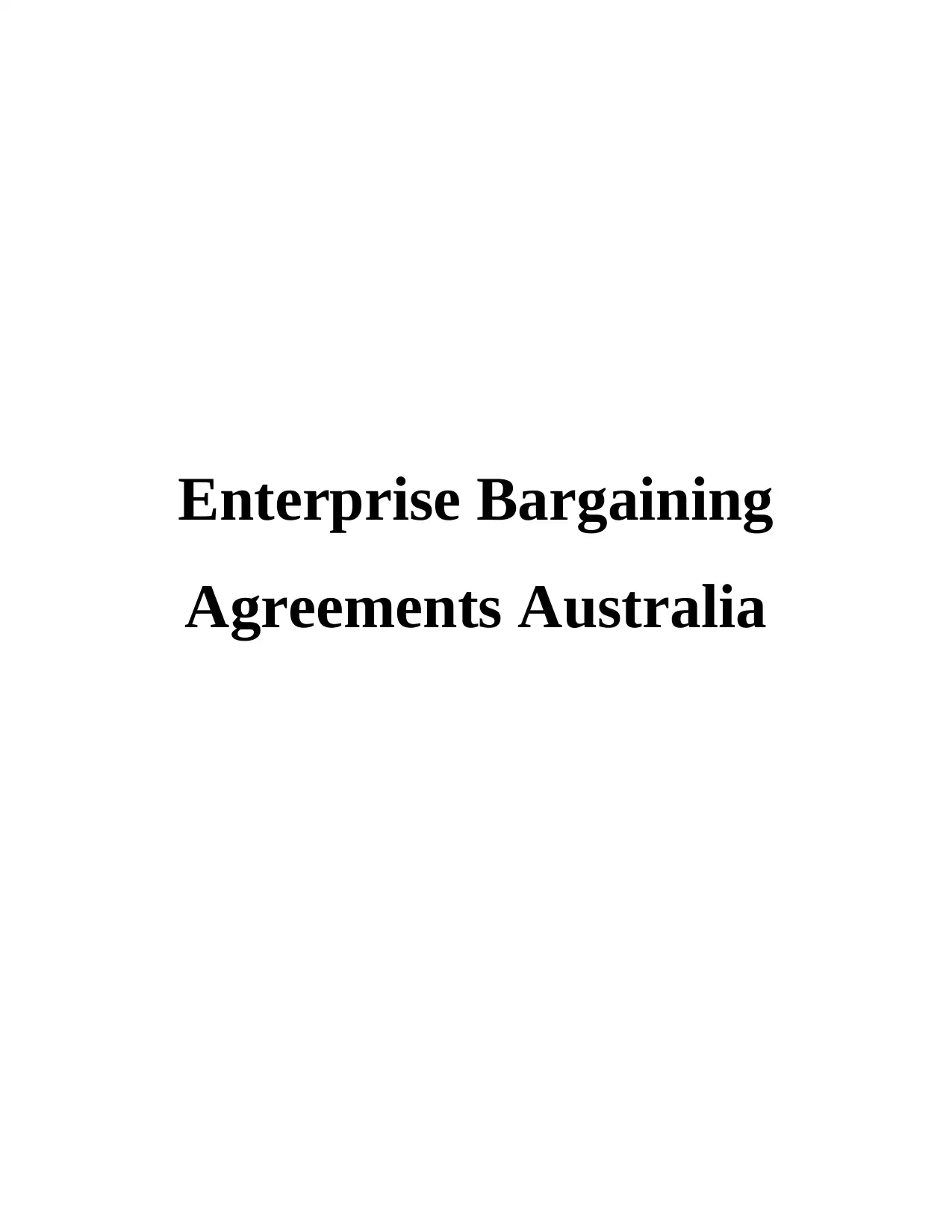
Enterprise Bargaining
Agreements Australia
Agreements Australia
Paraphrase This Document
Need a fresh take? Get an instant paraphrase of this document with our AI Paraphraser
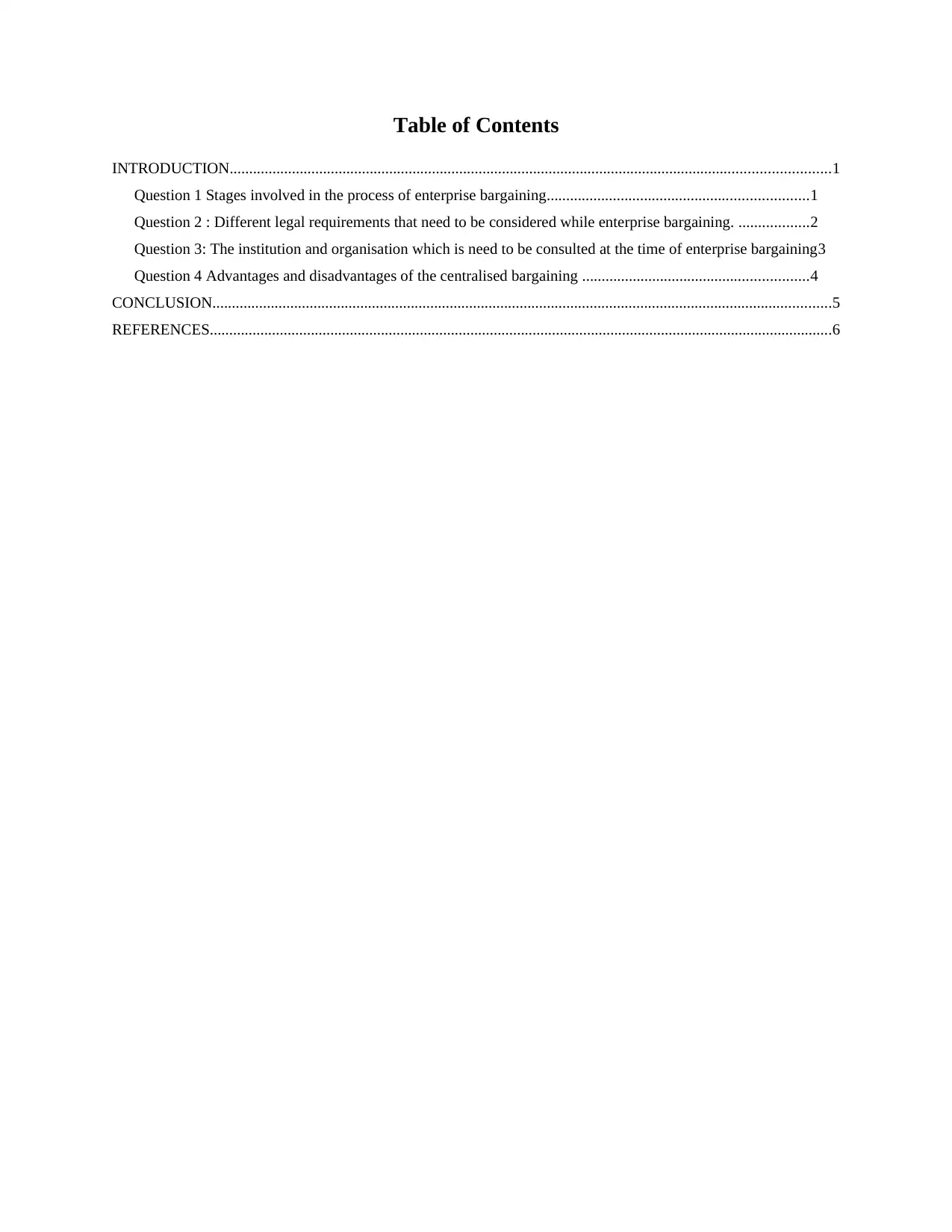
Table of Contents
INTRODUCTION..........................................................................................................................................................1
Question 1 Stages involved in the process of enterprise bargaining...................................................................1
Question 2 : Different legal requirements that need to be considered while enterprise bargaining. ..................2
Question 3: The institution and organisation which is need to be consulted at the time of enterprise bargaining3
Question 4 Advantages and disadvantages of the centralised bargaining ..........................................................4
CONCLUSION...............................................................................................................................................................5
REFERENCES................................................................................................................................................................6
INTRODUCTION..........................................................................................................................................................1
Question 1 Stages involved in the process of enterprise bargaining...................................................................1
Question 2 : Different legal requirements that need to be considered while enterprise bargaining. ..................2
Question 3: The institution and organisation which is need to be consulted at the time of enterprise bargaining3
Question 4 Advantages and disadvantages of the centralised bargaining ..........................................................4
CONCLUSION...............................................................................................................................................................5
REFERENCES................................................................................................................................................................6
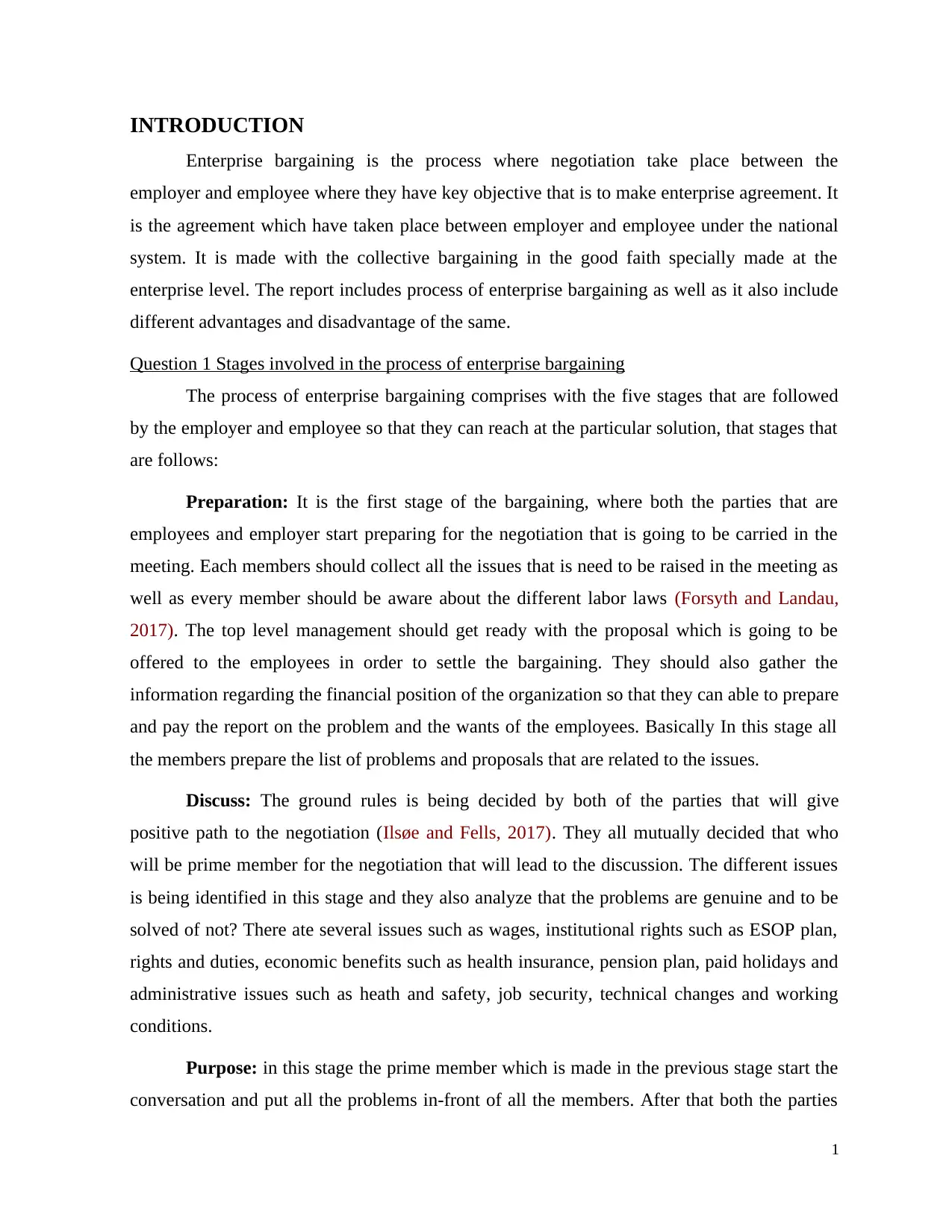
INTRODUCTION
Enterprise bargaining is the process where negotiation take place between the
employer and employee where they have key objective that is to make enterprise agreement. It
is the agreement which have taken place between employer and employee under the national
system. It is made with the collective bargaining in the good faith specially made at the
enterprise level. The report includes process of enterprise bargaining as well as it also include
different advantages and disadvantage of the same.
Question 1 Stages involved in the process of enterprise bargaining
The process of enterprise bargaining comprises with the five stages that are followed
by the employer and employee so that they can reach at the particular solution, that stages that
are follows:
Preparation: It is the first stage of the bargaining, where both the parties that are
employees and employer start preparing for the negotiation that is going to be carried in the
meeting. Each members should collect all the issues that is need to be raised in the meeting as
well as every member should be aware about the different labor laws (Forsyth and Landau,
2017). The top level management should get ready with the proposal which is going to be
offered to the employees in order to settle the bargaining. They should also gather the
information regarding the financial position of the organization so that they can able to prepare
and pay the report on the problem and the wants of the employees. Basically In this stage all
the members prepare the list of problems and proposals that are related to the issues.
Discuss: The ground rules is being decided by both of the parties that will give
positive path to the negotiation (Ilsøe and Fells, 2017). They all mutually decided that who
will be prime member for the negotiation that will lead to the discussion. The different issues
is being identified in this stage and they also analyze that the problems are genuine and to be
solved of not? There ate several issues such as wages, institutional rights such as ESOP plan,
rights and duties, economic benefits such as health insurance, pension plan, paid holidays and
administrative issues such as heath and safety, job security, technical changes and working
conditions.
Purpose: in this stage the prime member which is made in the previous stage start the
conversation and put all the problems in-front of all the members. After that both the parties
1
Enterprise bargaining is the process where negotiation take place between the
employer and employee where they have key objective that is to make enterprise agreement. It
is the agreement which have taken place between employer and employee under the national
system. It is made with the collective bargaining in the good faith specially made at the
enterprise level. The report includes process of enterprise bargaining as well as it also include
different advantages and disadvantage of the same.
Question 1 Stages involved in the process of enterprise bargaining
The process of enterprise bargaining comprises with the five stages that are followed
by the employer and employee so that they can reach at the particular solution, that stages that
are follows:
Preparation: It is the first stage of the bargaining, where both the parties that are
employees and employer start preparing for the negotiation that is going to be carried in the
meeting. Each members should collect all the issues that is need to be raised in the meeting as
well as every member should be aware about the different labor laws (Forsyth and Landau,
2017). The top level management should get ready with the proposal which is going to be
offered to the employees in order to settle the bargaining. They should also gather the
information regarding the financial position of the organization so that they can able to prepare
and pay the report on the problem and the wants of the employees. Basically In this stage all
the members prepare the list of problems and proposals that are related to the issues.
Discuss: The ground rules is being decided by both of the parties that will give
positive path to the negotiation (Ilsøe and Fells, 2017). They all mutually decided that who
will be prime member for the negotiation that will lead to the discussion. The different issues
is being identified in this stage and they also analyze that the problems are genuine and to be
solved of not? There ate several issues such as wages, institutional rights such as ESOP plan,
rights and duties, economic benefits such as health insurance, pension plan, paid holidays and
administrative issues such as heath and safety, job security, technical changes and working
conditions.
Purpose: in this stage the prime member which is made in the previous stage start the
conversation and put all the problems in-front of all the members. After that both the parties
1
⊘ This is a preview!⊘
Do you want full access?
Subscribe today to unlock all pages.

Trusted by 1+ million students worldwide
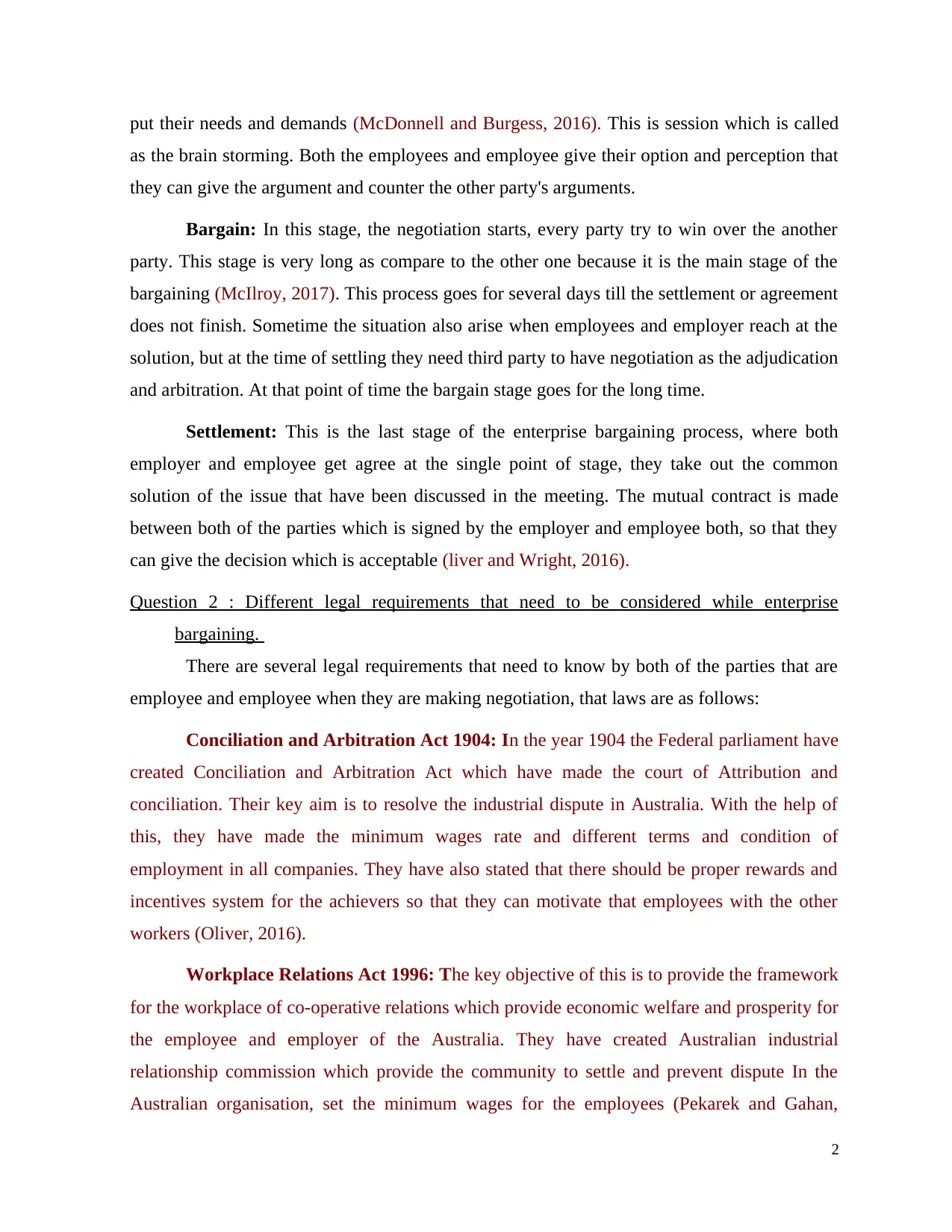
put their needs and demands (McDonnell and Burgess, 2016). This is session which is called
as the brain storming. Both the employees and employee give their option and perception that
they can give the argument and counter the other party's arguments.
Bargain: In this stage, the negotiation starts, every party try to win over the another
party. This stage is very long as compare to the other one because it is the main stage of the
bargaining (McIlroy, 2017). This process goes for several days till the settlement or agreement
does not finish. Sometime the situation also arise when employees and employer reach at the
solution, but at the time of settling they need third party to have negotiation as the adjudication
and arbitration. At that point of time the bargain stage goes for the long time.
Settlement: This is the last stage of the enterprise bargaining process, where both
employer and employee get agree at the single point of stage, they take out the common
solution of the issue that have been discussed in the meeting. The mutual contract is made
between both of the parties which is signed by the employer and employee both, so that they
can give the decision which is acceptable (liver and Wright, 2016).
Question 2 : Different legal requirements that need to be considered while enterprise
bargaining.
There are several legal requirements that need to know by both of the parties that are
employee and employee when they are making negotiation, that laws are as follows:
Conciliation and Arbitration Act 1904: In the year 1904 the Federal parliament have
created Conciliation and Arbitration Act which have made the court of Attribution and
conciliation. Their key aim is to resolve the industrial dispute in Australia. With the help of
this, they have made the minimum wages rate and different terms and condition of
employment in all companies. They have also stated that there should be proper rewards and
incentives system for the achievers so that they can motivate that employees with the other
workers (Oliver, 2016).
Workplace Relations Act 1996: The key objective of this is to provide the framework
for the workplace of co-operative relations which provide economic welfare and prosperity for
the employee and employer of the Australia. They have created Australian industrial
relationship commission which provide the community to settle and prevent dispute In the
Australian organisation, set the minimum wages for the employees (Pekarek and Gahan,
2
as the brain storming. Both the employees and employee give their option and perception that
they can give the argument and counter the other party's arguments.
Bargain: In this stage, the negotiation starts, every party try to win over the another
party. This stage is very long as compare to the other one because it is the main stage of the
bargaining (McIlroy, 2017). This process goes for several days till the settlement or agreement
does not finish. Sometime the situation also arise when employees and employer reach at the
solution, but at the time of settling they need third party to have negotiation as the adjudication
and arbitration. At that point of time the bargain stage goes for the long time.
Settlement: This is the last stage of the enterprise bargaining process, where both
employer and employee get agree at the single point of stage, they take out the common
solution of the issue that have been discussed in the meeting. The mutual contract is made
between both of the parties which is signed by the employer and employee both, so that they
can give the decision which is acceptable (liver and Wright, 2016).
Question 2 : Different legal requirements that need to be considered while enterprise
bargaining.
There are several legal requirements that need to know by both of the parties that are
employee and employee when they are making negotiation, that laws are as follows:
Conciliation and Arbitration Act 1904: In the year 1904 the Federal parliament have
created Conciliation and Arbitration Act which have made the court of Attribution and
conciliation. Their key aim is to resolve the industrial dispute in Australia. With the help of
this, they have made the minimum wages rate and different terms and condition of
employment in all companies. They have also stated that there should be proper rewards and
incentives system for the achievers so that they can motivate that employees with the other
workers (Oliver, 2016).
Workplace Relations Act 1996: The key objective of this is to provide the framework
for the workplace of co-operative relations which provide economic welfare and prosperity for
the employee and employer of the Australia. They have created Australian industrial
relationship commission which provide the community to settle and prevent dispute In the
Australian organisation, set the minimum wages for the employees (Pekarek and Gahan,
2
Paraphrase This Document
Need a fresh take? Get an instant paraphrase of this document with our AI Paraphraser
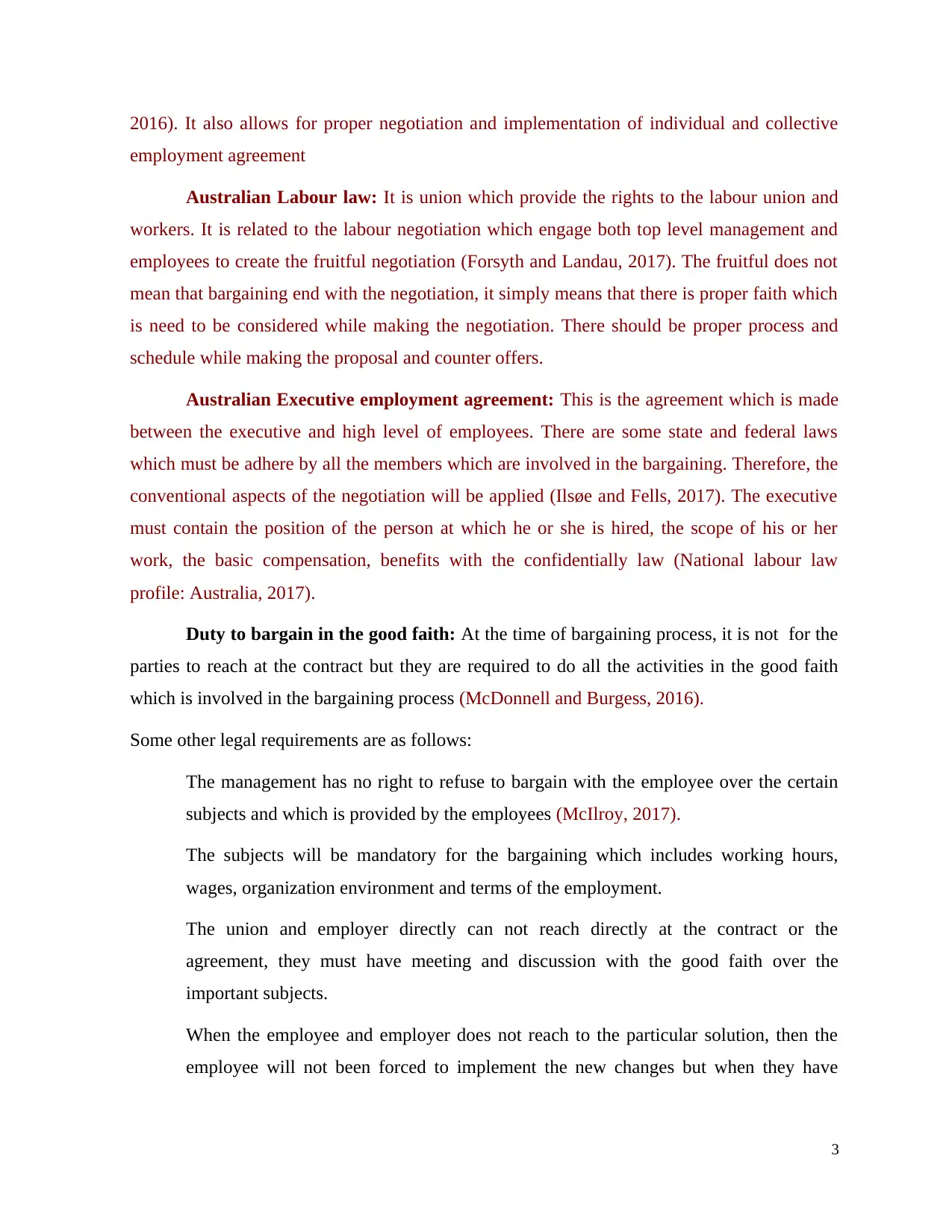
2016). It also allows for proper negotiation and implementation of individual and collective
employment agreement
Australian Labour law: It is union which provide the rights to the labour union and
workers. It is related to the labour negotiation which engage both top level management and
employees to create the fruitful negotiation (Forsyth and Landau, 2017). The fruitful does not
mean that bargaining end with the negotiation, it simply means that there is proper faith which
is need to be considered while making the negotiation. There should be proper process and
schedule while making the proposal and counter offers.
Australian Executive employment agreement: This is the agreement which is made
between the executive and high level of employees. There are some state and federal laws
which must be adhere by all the members which are involved in the bargaining. Therefore, the
conventional aspects of the negotiation will be applied (Ilsøe and Fells, 2017). The executive
must contain the position of the person at which he or she is hired, the scope of his or her
work, the basic compensation, benefits with the confidentially law (National labour law
profile: Australia, 2017).
Duty to bargain in the good faith: At the time of bargaining process, it is not for the
parties to reach at the contract but they are required to do all the activities in the good faith
which is involved in the bargaining process (McDonnell and Burgess, 2016).
Some other legal requirements are as follows:
The management has no right to refuse to bargain with the employee over the certain
subjects and which is provided by the employees (McIlroy, 2017).
The subjects will be mandatory for the bargaining which includes working hours,
wages, organization environment and terms of the employment.
The union and employer directly can not reach directly at the contract or the
agreement, they must have meeting and discussion with the good faith over the
important subjects.
When the employee and employer does not reach to the particular solution, then the
employee will not been forced to implement the new changes but when they have
3
employment agreement
Australian Labour law: It is union which provide the rights to the labour union and
workers. It is related to the labour negotiation which engage both top level management and
employees to create the fruitful negotiation (Forsyth and Landau, 2017). The fruitful does not
mean that bargaining end with the negotiation, it simply means that there is proper faith which
is need to be considered while making the negotiation. There should be proper process and
schedule while making the proposal and counter offers.
Australian Executive employment agreement: This is the agreement which is made
between the executive and high level of employees. There are some state and federal laws
which must be adhere by all the members which are involved in the bargaining. Therefore, the
conventional aspects of the negotiation will be applied (Ilsøe and Fells, 2017). The executive
must contain the position of the person at which he or she is hired, the scope of his or her
work, the basic compensation, benefits with the confidentially law (National labour law
profile: Australia, 2017).
Duty to bargain in the good faith: At the time of bargaining process, it is not for the
parties to reach at the contract but they are required to do all the activities in the good faith
which is involved in the bargaining process (McDonnell and Burgess, 2016).
Some other legal requirements are as follows:
The management has no right to refuse to bargain with the employee over the certain
subjects and which is provided by the employees (McIlroy, 2017).
The subjects will be mandatory for the bargaining which includes working hours,
wages, organization environment and terms of the employment.
The union and employer directly can not reach directly at the contract or the
agreement, they must have meeting and discussion with the good faith over the
important subjects.
When the employee and employer does not reach to the particular solution, then the
employee will not been forced to implement the new changes but when they have
3
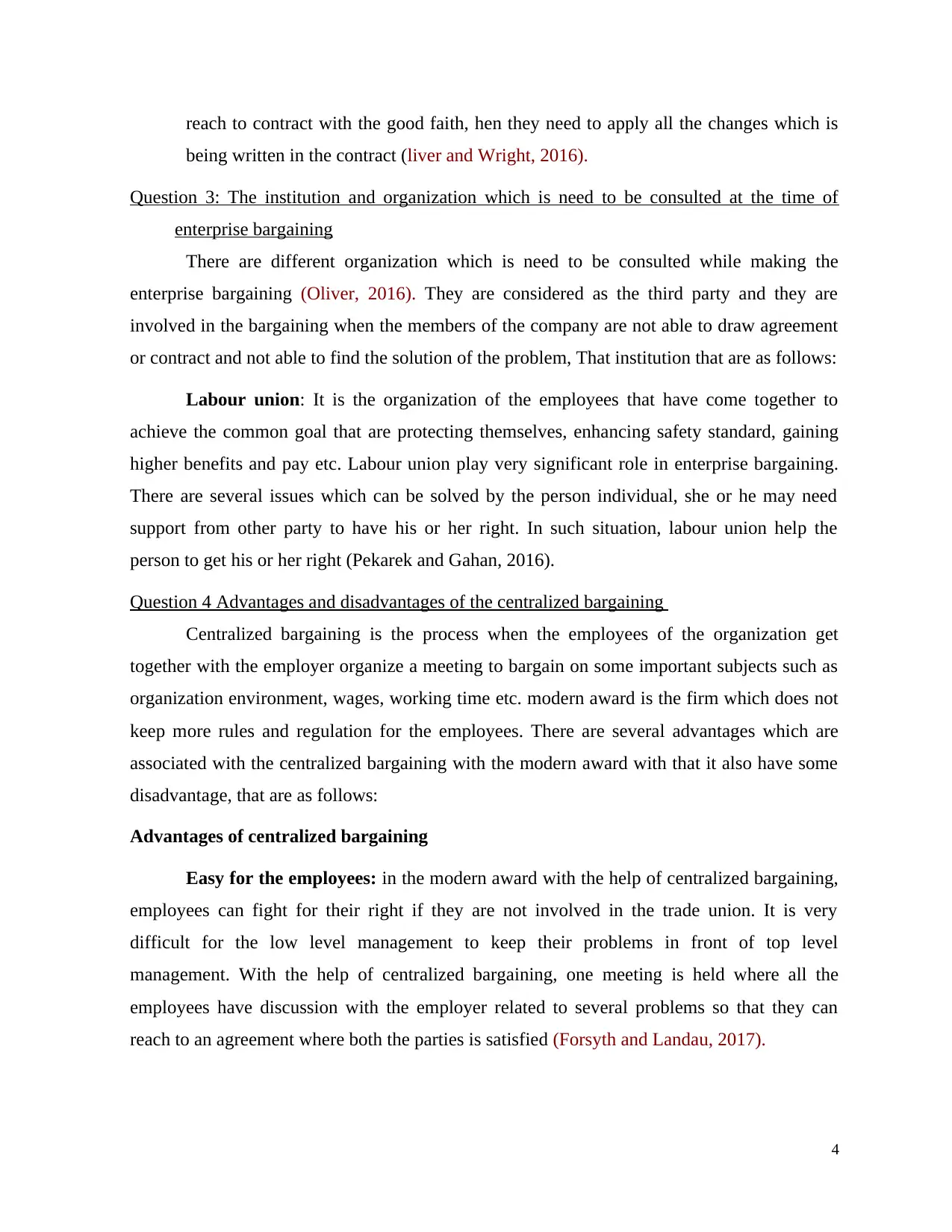
reach to contract with the good faith, hen they need to apply all the changes which is
being written in the contract (liver and Wright, 2016).
Question 3: The institution and organization which is need to be consulted at the time of
enterprise bargaining
There are different organization which is need to be consulted while making the
enterprise bargaining (Oliver, 2016). They are considered as the third party and they are
involved in the bargaining when the members of the company are not able to draw agreement
or contract and not able to find the solution of the problem, That institution that are as follows:
Labour union: It is the organization of the employees that have come together to
achieve the common goal that are protecting themselves, enhancing safety standard, gaining
higher benefits and pay etc. Labour union play very significant role in enterprise bargaining.
There are several issues which can be solved by the person individual, she or he may need
support from other party to have his or her right. In such situation, labour union help the
person to get his or her right (Pekarek and Gahan, 2016).
Question 4 Advantages and disadvantages of the centralized bargaining
Centralized bargaining is the process when the employees of the organization get
together with the employer organize a meeting to bargain on some important subjects such as
organization environment, wages, working time etc. modern award is the firm which does not
keep more rules and regulation for the employees. There are several advantages which are
associated with the centralized bargaining with the modern award with that it also have some
disadvantage, that are as follows:
Advantages of centralized bargaining
Easy for the employees: in the modern award with the help of centralized bargaining,
employees can fight for their right if they are not involved in the trade union. It is very
difficult for the low level management to keep their problems in front of top level
management. With the help of centralized bargaining, one meeting is held where all the
employees have discussion with the employer related to several problems so that they can
reach to an agreement where both the parties is satisfied (Forsyth and Landau, 2017).
4
being written in the contract (liver and Wright, 2016).
Question 3: The institution and organization which is need to be consulted at the time of
enterprise bargaining
There are different organization which is need to be consulted while making the
enterprise bargaining (Oliver, 2016). They are considered as the third party and they are
involved in the bargaining when the members of the company are not able to draw agreement
or contract and not able to find the solution of the problem, That institution that are as follows:
Labour union: It is the organization of the employees that have come together to
achieve the common goal that are protecting themselves, enhancing safety standard, gaining
higher benefits and pay etc. Labour union play very significant role in enterprise bargaining.
There are several issues which can be solved by the person individual, she or he may need
support from other party to have his or her right. In such situation, labour union help the
person to get his or her right (Pekarek and Gahan, 2016).
Question 4 Advantages and disadvantages of the centralized bargaining
Centralized bargaining is the process when the employees of the organization get
together with the employer organize a meeting to bargain on some important subjects such as
organization environment, wages, working time etc. modern award is the firm which does not
keep more rules and regulation for the employees. There are several advantages which are
associated with the centralized bargaining with the modern award with that it also have some
disadvantage, that are as follows:
Advantages of centralized bargaining
Easy for the employees: in the modern award with the help of centralized bargaining,
employees can fight for their right if they are not involved in the trade union. It is very
difficult for the low level management to keep their problems in front of top level
management. With the help of centralized bargaining, one meeting is held where all the
employees have discussion with the employer related to several problems so that they can
reach to an agreement where both the parties is satisfied (Forsyth and Landau, 2017).
4
⊘ This is a preview!⊘
Do you want full access?
Subscribe today to unlock all pages.

Trusted by 1+ million students worldwide
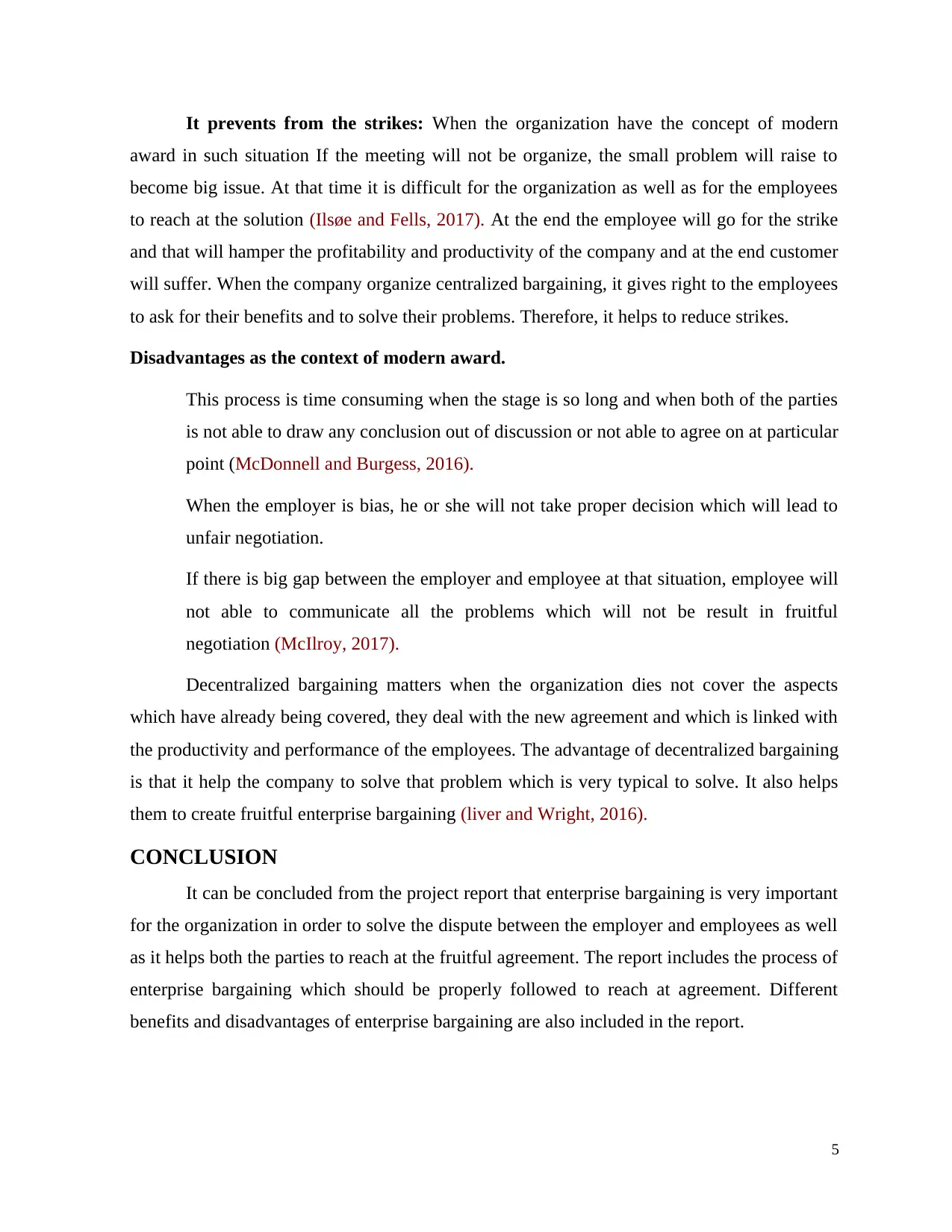
It prevents from the strikes: When the organization have the concept of modern
award in such situation If the meeting will not be organize, the small problem will raise to
become big issue. At that time it is difficult for the organization as well as for the employees
to reach at the solution (Ilsøe and Fells, 2017). At the end the employee will go for the strike
and that will hamper the profitability and productivity of the company and at the end customer
will suffer. When the company organize centralized bargaining, it gives right to the employees
to ask for their benefits and to solve their problems. Therefore, it helps to reduce strikes.
Disadvantages as the context of modern award.
This process is time consuming when the stage is so long and when both of the parties
is not able to draw any conclusion out of discussion or not able to agree on at particular
point (McDonnell and Burgess, 2016).
When the employer is bias, he or she will not take proper decision which will lead to
unfair negotiation.
If there is big gap between the employer and employee at that situation, employee will
not able to communicate all the problems which will not be result in fruitful
negotiation (McIlroy, 2017).
Decentralized bargaining matters when the organization dies not cover the aspects
which have already being covered, they deal with the new agreement and which is linked with
the productivity and performance of the employees. The advantage of decentralized bargaining
is that it help the company to solve that problem which is very typical to solve. It also helps
them to create fruitful enterprise bargaining (liver and Wright, 2016).
CONCLUSION
It can be concluded from the project report that enterprise bargaining is very important
for the organization in order to solve the dispute between the employer and employees as well
as it helps both the parties to reach at the fruitful agreement. The report includes the process of
enterprise bargaining which should be properly followed to reach at agreement. Different
benefits and disadvantages of enterprise bargaining are also included in the report.
5
award in such situation If the meeting will not be organize, the small problem will raise to
become big issue. At that time it is difficult for the organization as well as for the employees
to reach at the solution (Ilsøe and Fells, 2017). At the end the employee will go for the strike
and that will hamper the profitability and productivity of the company and at the end customer
will suffer. When the company organize centralized bargaining, it gives right to the employees
to ask for their benefits and to solve their problems. Therefore, it helps to reduce strikes.
Disadvantages as the context of modern award.
This process is time consuming when the stage is so long and when both of the parties
is not able to draw any conclusion out of discussion or not able to agree on at particular
point (McDonnell and Burgess, 2016).
When the employer is bias, he or she will not take proper decision which will lead to
unfair negotiation.
If there is big gap between the employer and employee at that situation, employee will
not able to communicate all the problems which will not be result in fruitful
negotiation (McIlroy, 2017).
Decentralized bargaining matters when the organization dies not cover the aspects
which have already being covered, they deal with the new agreement and which is linked with
the productivity and performance of the employees. The advantage of decentralized bargaining
is that it help the company to solve that problem which is very typical to solve. It also helps
them to create fruitful enterprise bargaining (liver and Wright, 2016).
CONCLUSION
It can be concluded from the project report that enterprise bargaining is very important
for the organization in order to solve the dispute between the employer and employees as well
as it helps both the parties to reach at the fruitful agreement. The report includes the process of
enterprise bargaining which should be properly followed to reach at agreement. Different
benefits and disadvantages of enterprise bargaining are also included in the report.
5
Paraphrase This Document
Need a fresh take? Get an instant paraphrase of this document with our AI Paraphraser
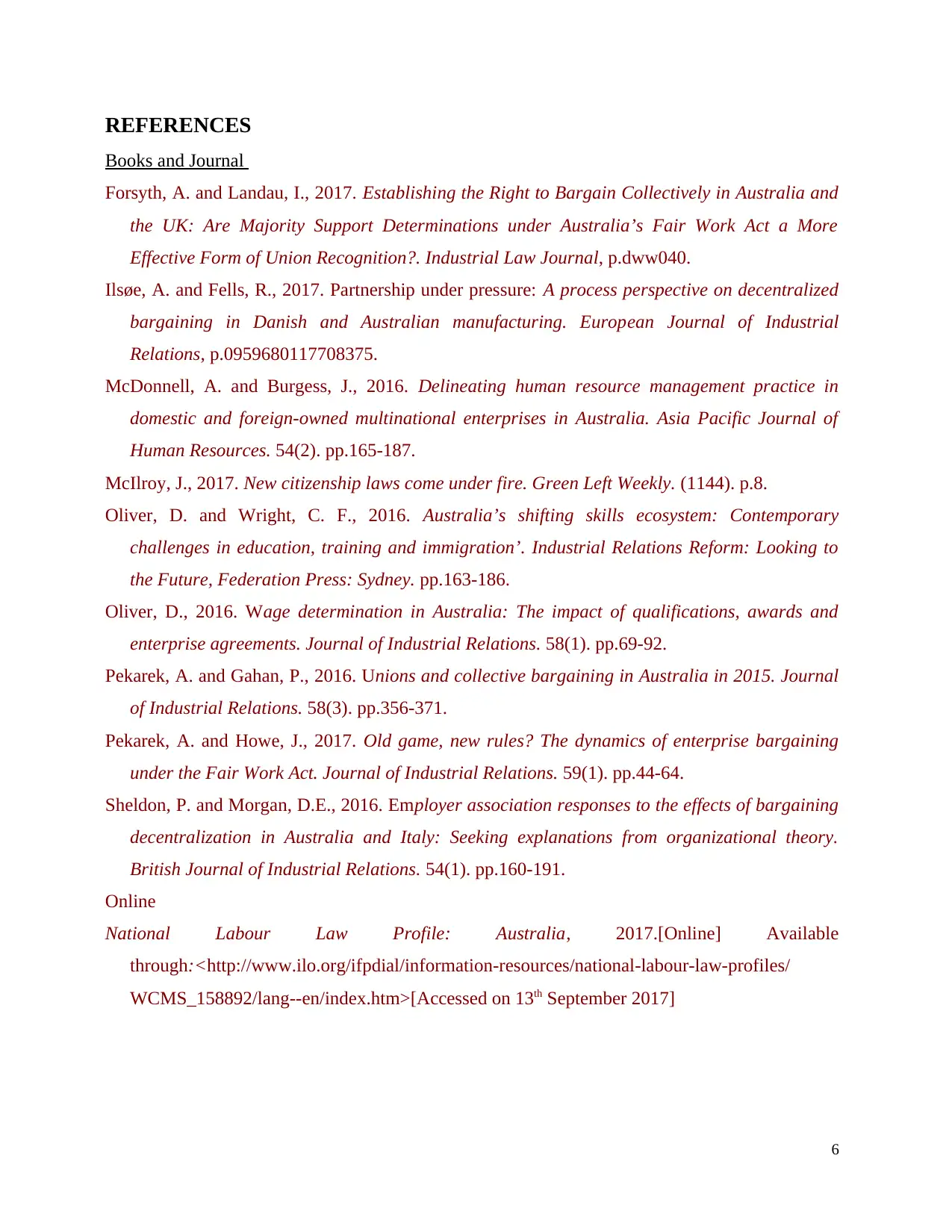
REFERENCES
Books and Journal
Forsyth, A. and Landau, I., 2017. Establishing the Right to Bargain Collectively in Australia and
the UK: Are Majority Support Determinations under Australia’s Fair Work Act a More
Effective Form of Union Recognition?. Industrial Law Journal, p.dww040.
Ilsøe, A. and Fells, R., 2017. Partnership under pressure: A process perspective on decentralized
bargaining in Danish and Australian manufacturing. European Journal of Industrial
Relations, p.0959680117708375.
McDonnell, A. and Burgess, J., 2016. Delineating human resource management practice in
domestic and foreign‐owned multinational enterprises in Australia. Asia Pacific Journal of
Human Resources. 54(2). pp.165-187.
McIlroy, J., 2017. New citizenship laws come under fire. Green Left Weekly. (1144). p.8.
Oliver, D. and Wright, C. F., 2016. Australia’s shifting skills ecosystem: Contemporary
challenges in education, training and immigration’. Industrial Relations Reform: Looking to
the Future, Federation Press: Sydney. pp.163-186.
Oliver, D., 2016. Wage determination in Australia: The impact of qualifications, awards and
enterprise agreements. Journal of Industrial Relations. 58(1). pp.69-92.
Pekarek, A. and Gahan, P., 2016. Unions and collective bargaining in Australia in 2015. Journal
of Industrial Relations. 58(3). pp.356-371.
Pekarek, A. and Howe, J., 2017. Old game, new rules? The dynamics of enterprise bargaining
under the Fair Work Act. Journal of Industrial Relations. 59(1). pp.44-64.
Sheldon, P. and Morgan, D.E., 2016. Employer association responses to the effects of bargaining
decentralization in Australia and Italy: Seeking explanations from organizational theory.
British Journal of Industrial Relations. 54(1). pp.160-191.
Online
National Labour Law Profile: Australia, 2017.[Online] Available
through:<http://www.ilo.org/ifpdial/information-resources/national-labour-law-profiles/
WCMS_158892/lang--en/index.htm>[Accessed on 13th September 2017]
6
Books and Journal
Forsyth, A. and Landau, I., 2017. Establishing the Right to Bargain Collectively in Australia and
the UK: Are Majority Support Determinations under Australia’s Fair Work Act a More
Effective Form of Union Recognition?. Industrial Law Journal, p.dww040.
Ilsøe, A. and Fells, R., 2017. Partnership under pressure: A process perspective on decentralized
bargaining in Danish and Australian manufacturing. European Journal of Industrial
Relations, p.0959680117708375.
McDonnell, A. and Burgess, J., 2016. Delineating human resource management practice in
domestic and foreign‐owned multinational enterprises in Australia. Asia Pacific Journal of
Human Resources. 54(2). pp.165-187.
McIlroy, J., 2017. New citizenship laws come under fire. Green Left Weekly. (1144). p.8.
Oliver, D. and Wright, C. F., 2016. Australia’s shifting skills ecosystem: Contemporary
challenges in education, training and immigration’. Industrial Relations Reform: Looking to
the Future, Federation Press: Sydney. pp.163-186.
Oliver, D., 2016. Wage determination in Australia: The impact of qualifications, awards and
enterprise agreements. Journal of Industrial Relations. 58(1). pp.69-92.
Pekarek, A. and Gahan, P., 2016. Unions and collective bargaining in Australia in 2015. Journal
of Industrial Relations. 58(3). pp.356-371.
Pekarek, A. and Howe, J., 2017. Old game, new rules? The dynamics of enterprise bargaining
under the Fair Work Act. Journal of Industrial Relations. 59(1). pp.44-64.
Sheldon, P. and Morgan, D.E., 2016. Employer association responses to the effects of bargaining
decentralization in Australia and Italy: Seeking explanations from organizational theory.
British Journal of Industrial Relations. 54(1). pp.160-191.
Online
National Labour Law Profile: Australia, 2017.[Online] Available
through:<http://www.ilo.org/ifpdial/information-resources/national-labour-law-profiles/
WCMS_158892/lang--en/index.htm>[Accessed on 13th September 2017]
6

7
⊘ This is a preview!⊘
Do you want full access?
Subscribe today to unlock all pages.

Trusted by 1+ million students worldwide
1 out of 9
Related Documents
Your All-in-One AI-Powered Toolkit for Academic Success.
+13062052269
info@desklib.com
Available 24*7 on WhatsApp / Email
![[object Object]](/_next/static/media/star-bottom.7253800d.svg)
Unlock your academic potential
Copyright © 2020–2025 A2Z Services. All Rights Reserved. Developed and managed by ZUCOL.





